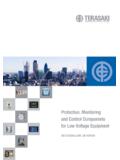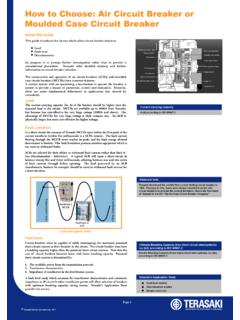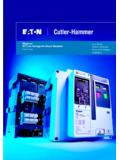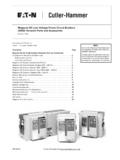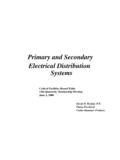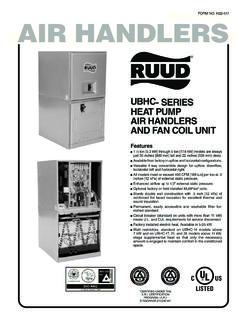Transcription of Condition Monitoring in Low Voltage Circuit …
1 1 Condition Monitoring in Low Voltage Circuit Breaker Technology Tom Craig (Hons) MIET Terasaki Electric (Europe) Ltd., UK 80 Beardmore Way, Clydebank Industrial Estate, Glasgow G81 4HT, SCOTLAND Keywords: Condition , temperature, Monitoring , Circuit breaker, maintenance Abstract Overheating is the single biggest cause of failure in switchgear. Modern Circuit protection is provided by digital overcurrent relays which are operated by current, not heat so abnormal heating caused by loose connection bolts, ventilation failure or worn contacts is usually left undetected by conventional Circuit breakers. This can lead to pre-mature failure of switchgear and also constitutes a potential fire hazard.
2 Thermal imaging can help prevent this but is only valid for that snapshot in time. Continuous Condition Monitoring of the temperature of switchgear can substantially minimise down time of the installation and reduce the risk of fire. 1 Introduction The overcurrent protection system used in low Voltage distribution (lower than 1000v ac rms) often plays second fiddle to its bigger relations in medium and high Voltage networks. However in terms of volume of protection devices it is one of the largest areas and if problems were to occur, the impact to the customer is the greatest. Two of the important protective devices utilised to protect modern low Voltage distribution systems is the Moulded Case Circuit Breaker (MCCB) and Air Circuit Breaker (ACB) Similar to other types of protection, these two areas have evolved to utilise microprocessors for overcurrent protection and all the well-known benefits that these provide.
3 Overheating of Circuit breakers can cause fire or explosion by igniting flammable materials. This can cause death, injury and considerable financial loss as documented by the Health and Safety Executive (HSE) [1]. If a Circuit breaker was to over-heat due to a loose connection, contact erosion or ventilation issues the traditional thermal magnetic Circuit breaker would self-protect itself and the installation. However microprocessor based Circuit breakers detect current not heat so the situation can arise where the load current is well within an acceptable threshold but an overheating situation can still occur resulting in a potential fire hazard.
4 Recent developments within microprocessor Circuit breakers provide the option of Monitoring the temperature of the contacts or terminals, continuously. If an abnormal Condition was to occur this information can be communicated to the Building Management System (BMS) to allow the facility manager, to plan for preventative maintenance before a critical power outage or even a fire hazard was to occur. Over the past decade the use of thermal imaging has helped greatly in this respect, however this only provides a snap shot in time and does not protect the low Voltage distribution system 24/7. The demand of critical installation such as data-centres, demand maximum power availability and minimum downtime.
5 This paper will explain in detail the technology used, real life applications and end user benefits gained from the introduction of such technology in low Voltage switchgear. The paper will also reference several case studies to illustrate the potential problems that have occurred and the solutions now available to improve the overcurrent protection model in low Voltage distribution. 2 Maintenance It is widely accepted by all switchgear manufacturers that overheating is one of the greatest risks that could result in premature ageing of switchgear, thus reducing the average Mean Time Between Failure ( ). At worst it can constitute a potential fire hazard, for both the Circuit breaker and installation itself.
6 Circuit breakers can be installed for many years, with often little or no maintenance compared to other equipment in low Voltage distribution. The lack of maintenance is usually the result of oversight, lack of knowledge of the equipment or pressures to avoid 2 plant shutdowns. Whatever the situation it will lead to a situation where switchgear has been neglected (this is particularly true of low Voltage devices, according to the Health & Safety Executive). The result is that routine servicing such as contact refurbishment and verification of contact engagement may not have been carried out for many years and deterioration due to corrosion may also have occurred [2].
7 After the transformer the incoming Circuit breaker, often an Air Circuit Breaker is one of the most important pieces of equipment. It is the gatekeeper to the low Voltage distribution network, but often receives less attention than other building services equipment such as Lighting, HVAC (Heating Ventilation Air Conditioning) & Security. If the incoming ACB should fail then all other equipment is redundant. If the system uses standby power through a Generator or (Uninterruptible Power Supply) then again it is normally the ACB that supplies this power. Condition Monitoring of Circuit breakers, particularly incoming Circuit breakers can greatly improve the reliability of the low Voltage network.
8 3 Circuit Breaker Design The majority of ACBs used are draw-out type. This provides easier access to the ACB and additional isolation which maintenance procedures may require. This requires the facilities use of isolating contacts for the interconnection between body and chassis. Figure 1 Draw-out ACB As the name suggests, the interrupting medium of the ACB is air and therefore sufficient space is required between the contacts to ensure effective arc extinction. Generally, due to space requirements, the majority of ACBs use one contact break per pole to interrupt any short Circuit . However, a few modern Circuit breaker manufacturers have introduced a DoubleBreak contact system (figure two).
9 This provides the opportunity to further elongate the arc to ensure even faster interruption of the short Circuit . Figure 2 ACB with Double Break System An additional benefit of this contact design is that the arc energy is shared between two sets of contacts so any contact surface erosion is greatly reduced, minimising build up of contact resistance and thus increasing its operational life. Whilst the ACB is the mechanical device that opens the contacts, the signal to do so normally comes from an integral protection relay. Unlike Moulded Case Circuit Breakers (MCCB) that sometimes have the option of being thermal magnetic or electronic, all protection relays on ACBs are electronic/microprocessor based, due to its larger current rating.
10 In a thermal magnetic MCCB, the internal bimetallic element responds to the true heating effect as a result of I2R losses. However an electronic MCCB or ACB protection relay responds to current not temperature . The electronic protection devices would model an inverse tripping curve proportional to the current. It does not detect anything that would result in an over-temperature situation, while a normal load current was being applied. 3 4 Sources of Overheating There are a number of sources that can contribute towards the overheating effect of any Circuit breaker; all of which can occur while it is carrying its normal full load current. If left undetected, this could result in the Circuit breaker having a reduced life span or at worst a fire hazard.



